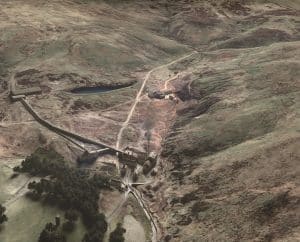Forteviot
Forteviot


On display at Perth Museum, Scotland
The fields around the modern village of Forteviot in Scotland contain one of the largest concentrations of prehistoric ritual monuments ever to be identified in Britain, dated at 2200-3000BC.
In the 1970s aerial reconnaissance recorded signs of these monuments in crop-markings. Subsequent aerial photography and archeological digs have presented an overall understanding of the complete prehistoric layout, however now-a-days there is nothing left visible on the surface.
The most spectacular feature was a huge circular palisaded enclosure more than 250m in diameter with a number of smaller henge monuments, barrow mounds and long barrow formations built within and around it.
It is thought the enclosure was a focus for high-status burials and pilgrimage.
The fields around the modern village of Forteviot in Scotland contain one of the largest concentrations of prehistoric ritual monuments ever to be identified in Britain, dated at 2200-3000BC.
In the 1970s aerial reconnaissance recorded signs of these monuments in crop-markings. Subsequent aerial photography and archeological digs have presented an overall understanding of the complete prehistoric layout, however now-a-days there is nothing left visible on the surface.
The most spectacular feature was a huge circular palisaded enclosure more than 250m in diameter with a number of smaller henge monuments, barrow mounds and long barrow formations built within and around it.
It is thought the enclosure was a focus for high-status burials and pilgrimage.
If you hover across the image you will see the scene illustrated at night.
Some believe the ‘cup and ring’ symbols commonly found in ancient prehistoric rock carvings were referencing the stars. Similar in form, these henge and barrow funerary structures may have been mirroring the night sky to immortalize their dead.

The image above illustrates the same scene at night.
Some believe the ‘cup and ring’ symbols commonly found in ancient prehistoric rock carvings were referencing the stars. Similar in form, these henge and barrow funerary structures may have been mirroring the night sky to immortalize their dead.










